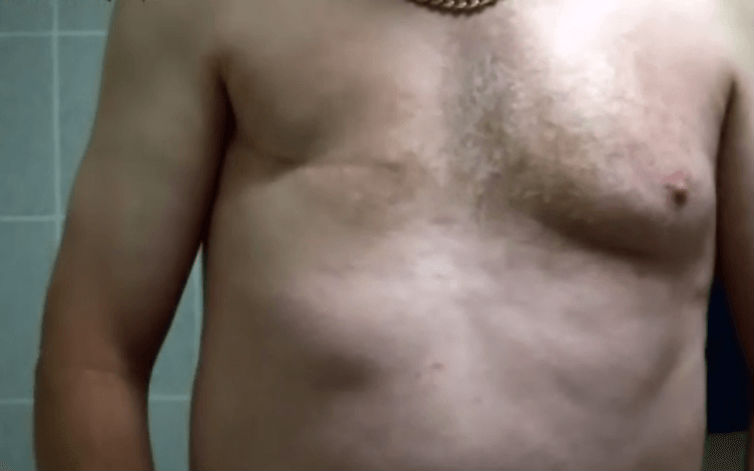E Times is considered a disease typical for women. But in 2015, The Conversation with breast cancer only in Australia was 145, out of which 25 were fatal. Men take up a bit less than 1% of all breast cancer cases, meaning that it’s more common than you think.
Male breast cancer shows ethnic differences: 7-14% of all breast cancers in sub-Saharan Africa occur in men; the highest rates of breast cancer in men in America happen in African-Americans, moderate in Asian-Pacific Islanders and non-Hispanic Caucasian men, and the lowest rates in Hispanic men.
Why Do Men Get Breast Cancer?
Although in much smaller amounts than women, men still have breast tissues that are exposed to much lower amounts of progesterone and estrogen hormones. Those men with higher levels of female hormones have a higher risk of breast cancer.
Rarely, breast cancer in men appears as a result of certain conditions which result in higher estrogen levels. Such examples are Klinefelter’s syndrome, a chromosomal disorder where patients aren’t able to produce enough testosterone, in cases of gender reassignment where people deliberately take estrogen, or because of obesity, chronic liver disease, or loss of the scrotum.
All these conditions can lead to gynecomastia (benign male breast enlargement). Older men with this condition are highly recommended to investigate it, particularly if it’s just on one side.
Male breast cancer usually develops over the age of 65-70. Those who have undergone chest radiotherapy have a higher risk. Estrogen positive (known as ER+ or estrogen receptor-positive) triggers 2/3 of female breast cancer cases, but in men, all cases of breast cancer are ER+.
Inherited predisposition to breast cancer has only a tiny proportion of the population. In families with BRCA1 or 2 (breast cancer gene), this type of cancer is more common in male members of the family than in the overall population.
Most cases of male breast cancer are felt as a hard lump, like the female, however, there are some other changes that can signal cancer, and they are nipple changes like nipple discharge, lumps under the arm, and changed breast shape. All these require investigations using an ultrasound, mammogram, and biopsy.
ER+ cancers have a pretty good survival rate. Approximately, over 85% of people diagnosed with ER+ cancer are alive and well after 10 years of their diagnosis.
Male breast cancer is usually discovered at a more advanced stage than female, probably because of not being identified properly, or because of the stigma about breast cancer in men.
How Is Male Breast Cancer Treated?
The usual procedure is a mastectomy to surgically remove all the breast tissue since the tumors can be large. After this, most of them will have to undergo radiotherapy. Otherwise, male breast cancer is treated similarly to female breast cancer. Some are recommended chemotherapy, especially when lymph glands are included, whereas the anti-estrogen drug Tamoxifen is recommended to all.
New drugs for female breast cancer block estrogen production, thus lowering the levels of estrogen to almost zero. However, these drugs are not effective in male breast cancer, since part of the testosterone, whose levels are higher in men, proceeds to be converted to estrogen, which is the reason why the growth of the tumor might not be successfully blocked.
The Reason for the Stigma?
Men’s refusal to seek medical care is partially the reason for the delayed identification of male breast cancer symptoms. But, there are probably going to be more issues connected to malignancy in an organ that they might be in denial about or even feel embarrassed about.
Certain differences have been noted in the decision-making and attitudes of both men and women, in correlation with carrying the genetic predisposition for breast cancer, which is the cause of about 10 percent of breast cancer in men.
The many “pink” campaigns for breast cancer awareness are probably worsening the stigma about male breast cancer.
Men can experience the side effects of cancer treatments in the same way as women. They can have problems accepting their diagnosis and body image, get hot flushes from Tamoxifen, change sexuality, fatigue, and other side effects of the treatment. Proper education about the occurrence, self-screening methods, and risk factors can help decrease the delay which is the reason for the late detection of male breast cancer.
Breast cancer counseling and nursing should be offered to all. Breast Cancer Network Australia offers proper guidelines and advice on breast cancer in men, as well as the great booklet called “Men get breast cancer too”. Cancer Australia also offers “Not Just a Woman’s Disease: Information about Breast Cancer in Men”.
Via IFL Science | The Conversation

